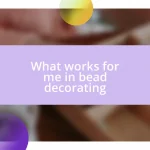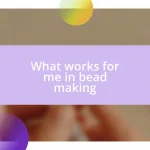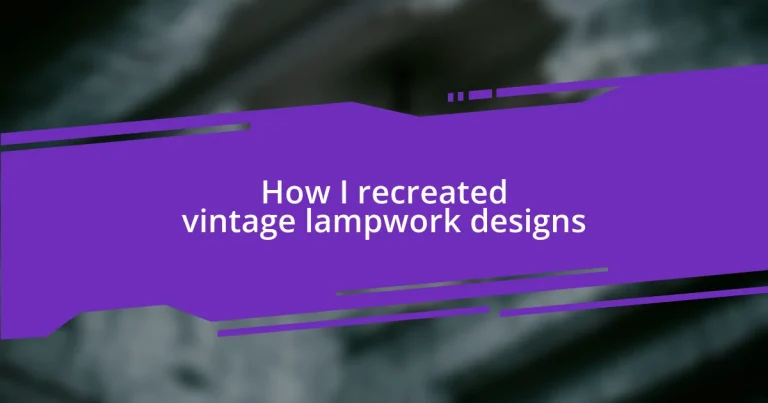Key takeaways:
- Vintage lampwork designs are intricate glass art pieces made by heating and manipulating glass rods, embodying stories and emotions related to their creators.
- Quality materials and essential tools, such as torches and safety glasses, are crucial for successful lampworking and achieving stunning designs.
- To explore vintage aesthetics, using muted color palettes, surface treatments, and vintage embellishments adds character and nostalgia to lampwork creations.

Introduction to vintage lampwork designs
Vintage lampwork designs are fascinating little pieces of art that carry stories and charm. I remember the first time I stumbled upon an exquisite lampwork pendant at a flea market; it was like finding a treasure. The intricate glass beads and their vibrant colors danced in the sunlight, capturing my imagination and igniting a passion I didn’t know I had.
Have you ever wondered how these stunning creations are made? Each piece is crafted by heating glass rods in a torch flame, skillfully manipulating them to form delicate shapes. The process is a blend of science and artistry, where the artist must understand temperature and viscosity to mold the glass properly. The thought of someone pouring their heart and soul into those small details touches me deeply.
Once you delve into vintage lampwork, you realize that these pieces are more than mere accessories; they are storytellers. Each bead reflects a bygone era, reminiscent of the artisans who poured their creativity into them. In my own attempts to recreate this style, I’ve often felt a profound connection to the past, as if I were channeling the spirits of those who came before me. It’s incredible how such small objects can evoke such strong emotions and inspire a desire to create in others!

Tools required for lampwork projects
Creating your own lampwork designs requires a set of essential tools that can make all the difference in your crafting experience. I remember the first time I gathered my supplies; the excitement of having everything I needed right at my fingertips felt like opening a door to a new world. Each tool plays a vital role, and understanding their functions can help elevate your projects to the next level.
Here’s a handy list of tools you’ll need for your lampwork endeavors:
- Torch: This is the heart of lampworking, used to melt the glass. A dual-fuel torch is ideal for beginner to advanced projects.
- Glass Rods: These come in various colors and types, forming the basis of your designs.
- Mandrels: These metal rods help shape your beads and keep them from sticking together.
- Safety Glasses: Protecting your eyes from the intense light of the torch is crucial.
- Kiln: After crafting, a kiln is essential for annealing your pieces, ensuring they don’t crack or break.
- Tweezers and Paddles: These tools help manipulate the molten glass into the desired shape.
- Release Agents: These prevent the glass from adhering to your mandrels during the melting process.
Each time I pull out my torch and glass rods, I feel a mix of anticipation and joy, almost like I’m about to create a little piece of history!

Gathering materials for lampwork
When it comes to gathering materials for lampwork, I find that it’s important to choose quality over quantity. During my early days, I often rushed to get supplies, thinking that any glass would do, but I quickly learned that the type of glass is crucial. High-quality soda-lime glass melts beautifully and allows for vibrant colors, while lower quality options can lead to disappointing results. I remember the first time I invested in premium glass—it felt like I was finally stepping into the world of real artistry.
In my experience, visiting a local glass supply shop is a great way to explore the myriad options available. There’s something electric about standing in front of shelves filled with colorful rods, letting your creativity take the lead. I’ve often spent hours just browsing, inspired by the different hues and textures. And it’s not just about glass; don’t forget the importance of careful selection for tools and safety materials. Having the right tools makes the entire experience smoother and more enjoyable.
Here’s a quick comparison to help you understand the differences between various types of glass:
| Type of Glass | Characteristics |
|---|---|
| Soda-Lime Glass | Most common; easy to melt and shape; ideal for beginners. |
| Borosilicate Glass | More heat resistant; ideal for intricate designs but requires more skill to work with. |
| Fused Glass | Often used for layering; adds texture and depth but may need additional techniques. |
Investing time in selecting quality materials really pays off in the final product. I’ve seen my designs evolve dramatically once I switched to better glass—it’s like the colors sing on their own!

Techniques for creating lampwork beads
Techniques for creating lampwork beads
One technique I often rely on is the use of heat control combined with movement. When I manipulate the molten glass, the rhythm feels almost like dancing—it’s all about knowing when to coax it gently into shape and when to apply a bit more heat. I vividly recall struggling at first; the glass often took on a mind of its own. However, as I practiced, I developed a sense of intuition that has become invaluable. Isn’t it fascinating how much control we can gain through experience?
The layering technique also plays a significant role in my bead-making. By applying different colors of molten glass over one another, I create depth and visual intrigue. I remember the first time I experimented with layering—I was both nervous and excited. Watching the colors meld together was like witnessing magic. It reminded me that every layer added not just color but also a part of my creative journey. Do you see how layering can transform a simple bead into a mini masterpiece?
Finally, I’ve found that incorporating textured surfaces can elevate a design from ordinary to extraordinary. Tools like paddles, needles, or even my own fingers help me create unique patterns on the glass. One day, while experimenting with a simple paddle, I unexpectedly created a ripple effect that added a stunning tactile quality to my bead. I still smile every time I see it. Have you ever stumbled upon a technique by accident that turned into one of your favorites? It’s those delightful surprises that make lampworking so rewarding!

Tips for achieving vintage finishes
To achieve vintage finishes in lampwork designs, I recommend embracing a muted color palette. When I first started experimenting with colors, I gravitated towards bright, bold options. However, I soon discovered that soft pastels and earthy tones evoke that nostalgic feel. Have you ever noticed how certain colors can transport you back in time? Incorporating subtle variations can make all the difference in achieving that authentic vintage vibe.
Another tip that has worked wonders for me is the use of patinas or surface treatments. These techniques can give your pieces a beautifully aged look. I remember the first time I applied a light oxidation finish—I was amazed at how it instantly added character to my lampwork. It’s like uncovering a hidden story within the glass. If you’re looking to add depth and authenticity, experimenting with various treatments can really elevate your work.
Finally, consider incorporating vintage embellishments or elements into your designs. I’ve found that elements like lace patterns or floral motifs can provide a charming touch. One of my favorite beads features a delicate floral design, and every time I see it, it brings back memories of my grandmother’s garden. Doesn’t it feel special to connect your art with personal history? Creating pieces that reflect both your style and vintage inspiration not only nurtures creativity but also tells a story that resonates with others.

Displaying and using lampwork designs
Displaying lampwork designs can be a true art form in itself. I love choosing unique display options that not only showcase the beauty of each piece but also reflect my personal style. For example, I sometimes use reclaimed wood to create stands; I find that the rustic texture beautifully contrasts with the glass’s smoothness. Have you ever considered how the right display can turn an object into a conversation starter?
When it comes to using lampwork beads, I often enjoy combining them into jewelry. Recently, I crafted a stunning necklace that incorporated my favorite multicolored lampwork beads, and wearing it feels like carrying a piece of my creativity with me. The compliments I receive remind me how pieces can evoke emotions and stories, making them even more special. They truly become wearable art, don’t they?
Moreover, incorporating lampwork pieces into home decor adds a personal touch that can’t be replicated. I’ve created simple glass jars filled with colorful lampwork beads, which I use as centerpieces for my dining table. Each glance at those jars brings me joy, recalling the memories and the labor of love behind the creation of each bead. Isn’t it fulfilling to create functional art that not only beautifies your space but also sparks nostalgia?














